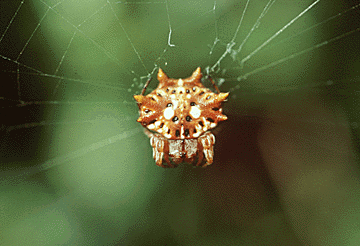Published in the Ocean Watch column, Honolulu Star-Advertiser © Susan Scott
July 19, 1999
A North Shore fisherman, Steve, called me with an interesting question. At night, he and a fellow angler like to set their poles in the sand on a Mokuleia beach. About half an hour later, when the men check the poles, they are covered with spider threads.
Steve said it’s hard to get a good look at the busy web-makers in the dark, but by flashlight the creatures look reddish, are a bit smaller than a dime and have light undersides. The men want to know: What are they and why are they out on the sand? The nearest bushes are about 25 feet from the fishing poles.
One group of spiders in Hawaii matches this physical and behavioral description almost perfectly — the spiny-backed spiders.
Two types of spiny-backed spiders have been imported to Hawaii from other areas. One is the Asian spiny-backed spider, with a reddish-brown back; another is the common spiny-backed spider, with a red and white back.
The first Asian spiny-backed spider was noticed on the Big Island in 1985. Since then, these spiders have spread to Maui, Molokai, Kauai and Oahu.
Spiny-backed spiders are outside creatures, rarely venturing indoors. These spiders have crab-shaped bodies about a half-inch in diameter. (A dime is just over a half-inch wide.) They build large webs on trees, shrubs, telephone poles and lines, and other human-made structures including, apparently, fishing poles, if given the opportunity.
The webs trap insects which the spider then eats.
 An Asian spiny-backed spider.
An Asian spiny-backed spider.
©1999 Susan Scott
In my North Shore neighborhood, not far from where Steve fishes, these spiders and webs are marvels to behold. Some bougainvillea bushes near my house are spider high-rises, packed full of the colorful spiny-backs either spinning, dangling or lying in wait. I feel sad when the bushes get pruned, but not for long, because the busy little creatures soon are back to their building.
So what are these spiders doing at the beach at night? According to Bishop Museum entomologist Gordon Nishida, they’re probably ballooning. Nishida explained that when baby spiny-backed spiders are ready to leave the nest, each spins a string of silk and takes off on it in the wind. This so-called ballooning is the way most spiders travel to new areas.
When a tall structure like a fishing pole appears in the vicinity, the young spiders, thinking they’ve found a place to settle down, start building a new home. This isn’t unusual at night because these spiders are most active then.
Spiny-backed spiders are beautiful to look at, but like all spiders, they bear venom and are capable of biting humans.
Usually, spiny-backed spiders don’t bite us because they aren’t interested in eating people. But if one falls onto an arm or into a shirt, they will sometimes chomp down.
It you’re bitten by one of the creatures, you’ll know it: The bite is sharp and painful. Fortunately, even though the bite site may swell and turn red, the venom from these spiders is not medically dangerous.
I’ve known and admired spiny-backed spiders for some time but I didn’t know they were beach-goers too. Next time I’m at the beach at night, I’ll try setting up a pole-home for these versatile little travelers.